Your dog is an important part of your family and you want to do everything you can to keep him happy, healthy and safe in your home. Maybe your senior dog is starting to have problems getting up and down the stairs and you’re looking for a solution. Or maybe you want to find a way to keep your dog from tracking mud and dirt into your house. You want your home to be comfortable and clean and you’d like it to be enjoyable for your dog as well. So here are a few tips to help you make your home dog friendly.
Dog Proofing Your Home
Just like baby proofing, you need to make sure your home is safe for your dog. Take a walk around your house and look for areas that could be dangerous. Dogs (especially puppies) are curious by nature and if there’s something they can get into, there’s a good chance they will. If possible, get down to your dog’s eye level so you can get a clear idea of what he sees. Once you start to experience a “dog’s eye view” of your home, you might be surprised at how many hazards you actually find. Remember, there are some things in your house that might not be dangerous to you, but they can still be bad for your dog.
Kitchens and bathrooms are common places in your home where there could be dangerous items, such as medications or cleaning supplies. These are the two rooms where dog-proofing is very important as you make your home dog friendly.
Go through your kitchen and search for objects or areas that could be hazardous to your dog. Most likely you have kitchen appliances with doors, such as your refrigerator, dishwasher and microwave. These should always be kept securely closed as some dogs might climb inside and become trapped (the same goes for your washer and dryer). Also, do you have spaces, gaps or holes around your refrigerator or other large appliances? If so, you’ll want to put up blockades to keep your dog from getting stuck.
See if you have step stools or anything else that your dog could use to climb on to tables or counter tops – if so, you’ll want to remove them. Put childproof locks on all of your kitchen cabinets that are floor-level, especially if this is where you keep your cleaning supplies. Keep food out of reach from your dog and store your trash bins in a place where your dog can’t get into them. Chicken bones, coffee grinds and chocolate can be harmful or even fatal to your dog, so empty your trash regularly and use a trash bin that has a tight-fitting lid.
Next, go through the bathroom and put childproof locks on all the cabinets that are floor level, especially the ones where you store makeup or medications. If possible, put anything hazardous in a cabinet that your dog can’t reach. Ideally, you should use non-toxic products to clean your toilet bowl, and keep the lid closed after each use. Drinking water from the toilet isn’t safe for your dog, plus small dogs could fall in and potentially drown.
Go through your living room and family room and look for possible choking, electrocution or suffocation hazards. Hide any exposed wires or cables safely behind your furniture and also get a thick cable protector for the wires and cables. It’s also a good idea to get electrical outlet covers for extra protection as well. If you have drapes or window treatments with dangling cords, cut the loop in the cord and keep them tied up high. If you have open windows in your house, make sure you have locked screens on all the windows so your dog can’t fall out. Take a look at your furniture and try to use coffee tables and end tables with round edges (and no glass) so your dog won’t get hurt when he’s running and playing inside the house. And if you have any valuable or fragile collectible items, you’ll want to store them on higher shelves where your dog can’t knock them down. Another important way to make your home dog friendly is to remove house plants that could be harmful to your dog. Mistletoe, philodendrons, lilies and poinsettias are all common plants that we find in the home and they are all toxic to pets if consumed.
Bedrooms can be dog proofed by removing any medication that’s left on the bedside table. You’ll want to keep your shoes in a place where curious puppies can’t chew them, and also put away any children’s toys that your dog could choke on. If you have an older dog who sleeps on your bed, you can set up a ramp or stairs next to your bed so he has an easier time getting up and down. Investing in a baby gate is also a great way to keep your pooch out of areas where he shouldn’t be, especially when you’re not around to supervise.
When it comes to painting your walls, you’ll want to use a semi-gloss paint especially in rooms where your dog spends most of his time. Semi-gloss paint is easy to clean with soap and water and can be touched up quickly if it gets nicked or scratched. If you decide you want to use wallpaper or fabric wall treatments, keep it to the top half of the walls or in rooms where your dog rarely visits.
Now, check out your garage and backyard just as you did with the inside of your home – there could be a number of items that are dangerous to your dog. If you have any chemicals, paint or antifreeze in your garage, keep them stored high up in a cupboard or in a locked closet. Likewise, gather up your sharp tools and keep them stored in a space that is safe from your dog. And finally, do some research and learn what outdoor plants are bad for your dog and create a backyard that’s safe for your dog to play in.
Dog Friendly Flooring
If you want carpeting in your home, you can select from a large variety of pet friendly carpet that is durable and easy to clean. The advantage to carpet is that it’s more comfortable for your dog to sleep on and it’s not slippery like other flooring materials. Your best choice would be low pile carpet and you should select a color that is earth toned or multicolored to help mask stains or pet hair between cleaning. Another option to wall-to-wall carpet are carpet tiles where you can easily remove or replace one tile of carpet without having to remove the entire flooring. You can keep your carpet clean by vacuuming regularly and by grooming your dog often to help remove shedding hair. You can also give your dog MaxiDerm Skin and Coat Formula to help with shedding. If your dog happens to have an accident on your clean carpet, you’ll want to immediately use a pet-safe carpet cleaner so that odor and stains don’t have a chance to set in.
Hardwood floors are beautiful and easy to clean, but they can get scratched or nicked by your dog’s nails. If you want hardwood floors in your home, you’re better off selecting a durable wood such as oak, cherry or mahogany. Wood floors made of cedar or pine typically are softer and are more susceptible to being scratched or damaged. Hardwood floors can be slippery, so you’ll want to add additional area rugs to help give your dog some traction. Also, you can keep your hardwood floors in good condition by keeping your dog’s nails trimmed and by immediately cleaning up any spills to help prevent staining or warping of the wood.
Ceramic tile and laminate flooring are popular choices, too, since they are easy to clean and are fairly resistant to dog stains. They are also scratch resistant and are cool for your dog to sleep on during the hot, summer months. On the downside, ceramic tiles and laminate floors can be slippery so you’ll need to add extra rugs in these areas.
When selecting floor rugs to help make your home dog friendly, you should pick rugs that are stain resistant and are also machine washable. Indoor-outdoor rugs are good choices, since they are durable and don’t have high loops that your dog could get his nails hooked on. The rugs should include non-skid pads or double sided tape underneath them so your dog can run without risking the danger of slipping and falling. You can also select floor rugs that match the color of your dog’s hair – that way you won’t have to vacuum as often and any extra dog hair that accumulates between cleaning will not be quite so visible. If you have hardwood floors or ceramic tiles, you’ll want to use plenty of rugs throughout the house, especially if you have an older dog. Sometimes older dogs have trouble getting up and down, so they’ll need the extra traction of floor rugs (they will also benefit from taking joint supplements for dogs such as InflamAway HA).
Furniture
If you want dog-friendly furniture that is easy to clean, try to avoid light colored upholstery that will quickly show stains or markings. Stay away from furniture that’s made from fabrics such as silk, velvet or chenille that can easily get damaged and are also magnets for pet hair. Leather, faux leather, vinyl and microsuede fabrics are your best choices since they do not absorb odors and are very easy to clean. Also, get furniture that has legs instead of skirts – this will also reduce the amount of dog hair that ends up on your couches and chairs.
Machine washable slip covers and throw blankets can become your best friend – they will help protect your furniture from being scratched or punctured by your dog’s nails. Throw blankets come in a large variety of sizes, materials and stylish patterns so you can find something to match every room. You could, of course, try to enforce a “no-furniture” rule for your dog, but as we all know, that doesn’t always work!
For the bedrooms, you’ll want to use removable duvet covers to protect your quilts and comforters. Duvet covers are both durable and washable, and also come in a variety of patterns and sizes.
Create Dog Friendly Spaces
We’ve all experienced it – our jubilant dog comes tearing into the house after playing outside, bringing along with him a trail of mud, dirt and dust. You can keep your house clean by creating a dog cleaning station or a “mudroom” at the entrance of your home. The flooring should be tile or linoleum and the walls can be painted with semi-gloss paint that’s easy to wipe down with a sponge. Next, place a doggie doormat on the floor that is specially designed to soak up mud and dirt. Add in a bench seat with storage or some built in shelving, and keep it well stocked with a fresh supply of clean towels, baby wipes, brushes and outdoor apparel. By wiping off your dog’s feet, legs and body before he comes inside, you’ll be able to reduce the amount of dirt that gets tracked through your home. If you have the room and you want to get fancy, you can even create a built in bathing station with a doggie shower or bath!
A Special Space
Just like people, dogs sometimes need a quiet place where they can be alone, either to sleep or just to relax without interruptions. See if you can pick a room that you don’t use – maybe a spare bedroom or empty office space that you can designate as your dog’s room. Make the room as cozy as you can for your dog, and he’ll quickly learn that this is his “safe” place to go when he wants peace and quiet. Look for a comfy dog bed or sofa that fits your dog’s frame and size and add some extra blankets or pillows that he can curl up with – there is an amazing selection to choose from and surely you’ll find something that will match your home decor. Set up a feeding area with food and water bowls and place a large, plastic place mat under the dishes so it’ll be easy to clean up spills. If you have an older dog, you can also get raised dishes so that he won’t have to bend down as far to eat or drink. And of course, add a sturdy basket where you can store some of his favorite toys. If you want to, you can also get a small chest of drawers where you can store some extra toys, cleaning towels and even some special treats.
We all love our dogs and want our homes to be safe and dog friendly. Let us know if you have any tips on ways to turn your home into a space that both and your dog can enjoy.

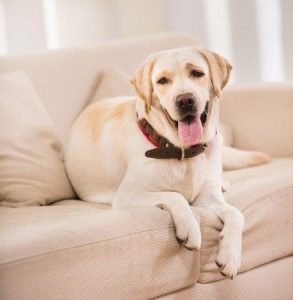
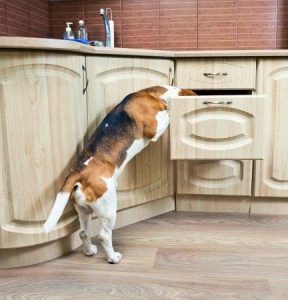
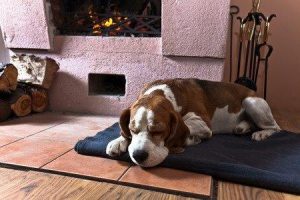
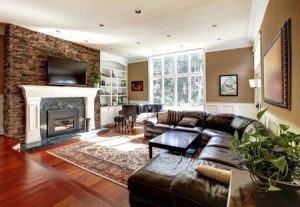
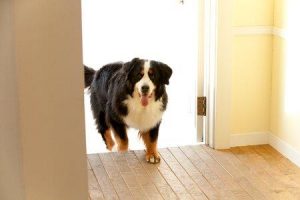


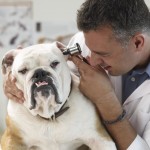

Leave a Reply